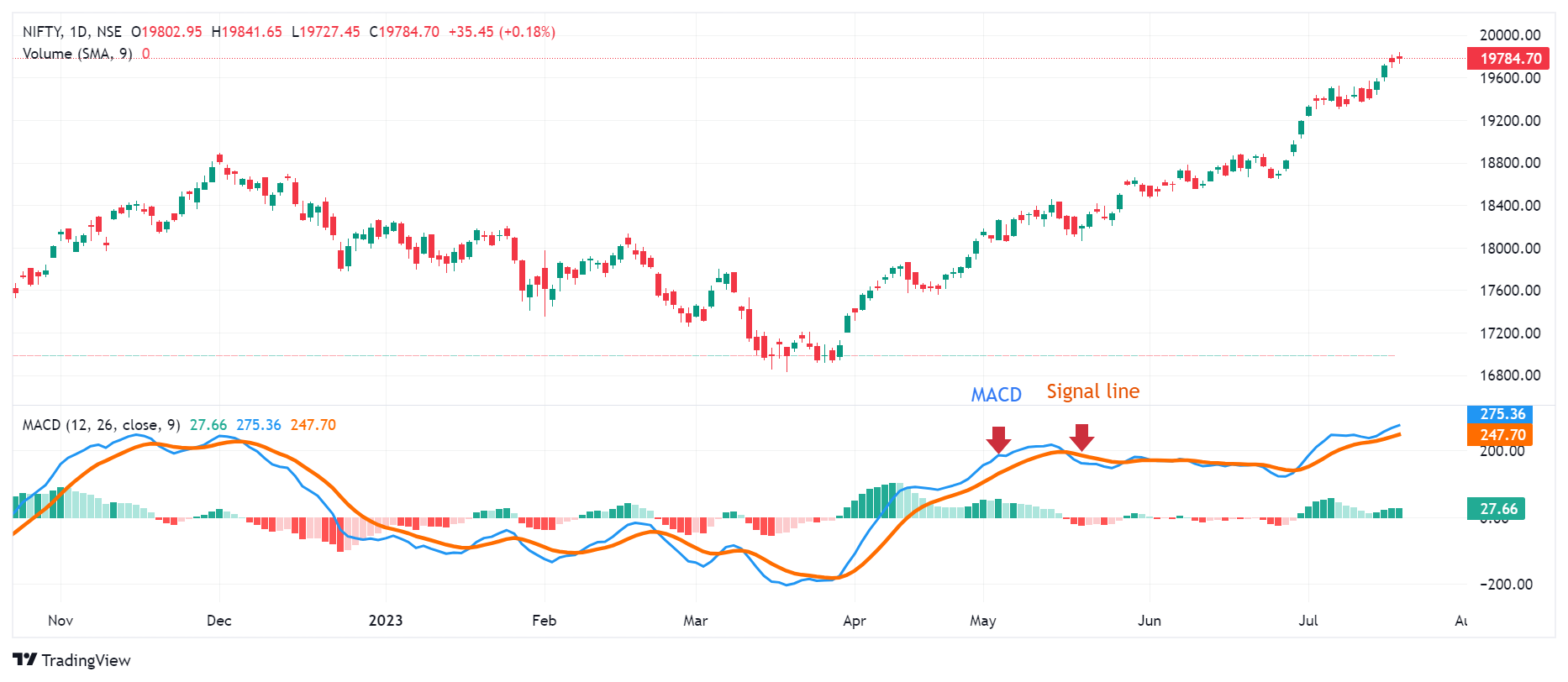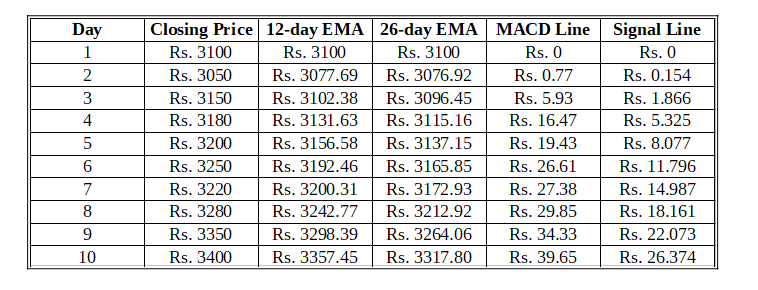UNDERSTANDING THE POWER OF MOVING AVERAGE CONVERGENCE DIVERGENCE (MACD) IN THE STOCK MARKET
In the ever-evolving landscape of the stock market, traders rely on a range of technical indicators to gain insights and make informed decisions. One such indispensable tool is the Moving Average Convergence Divergence (MACD) indicator. The MACD is a versatile and widely used indicator that helps traders identify potential trend reversals, gauge market momentum, and generate timely buy and sell signals. In this blog post, we will explore the significance of the Moving Average Convergence Divergence as a technical indicator in the stock market.

Understanding Moving Average Convergence Divergence (MACD)
The Moving Average Convergence Divergence (MACD) is a trend-following momentum oscillator that consists of three components: the MACD line, the signal line, and the histogram. The MACD line is calculated by subtracting a longer-term Exponential Moving Average (EMA) from a shorter-term EMA. The signal line, often a 9-period EMA of the MACD line, acts as a trigger line for buy and sell signals. The histogram represents the difference between the MACD line and the signal line, providing visual cues about the strength and direction of the trend.
How to apply MACD indicator in real life
Let's take an example of a real-life Indian stock, such as Tata Consultancy Services (TCS), and use the Moving Average Convergence Divergence (MACD) indicator to explain changes in position.
The MACD is a popular trend-following momentum indicator that helps traders identify the strength and direction of a stock's trend. It consists of two lines: the MACD line and the signal line.
Here's how the MACD is calculated:
- Calculate the 12-day Exponential Moving Average (EMA) of the stock's closing prices.
- Calculate the 26-day Exponential Moving Average (EMA) of the stock's closing prices.
- Subtract the 26-day EMA from the 12-day EMA to get the MACD line.
- Calculate a 9-day Exponential Moving Average (EMA) of the MACD line to get the signal line.
Let’s look at an example of Tata Consultancy Services (TCS) using the Moving Average Convergence Divergence (MACD) indicator presented in a tabular format:

In the table above:
- "Closing Price" represents the daily closing price of TCS stock.
- "12-day EMA" and "26-day EMA" are the calculated 12-day and 26-day Exponential Moving Averages, respectively.
- "MACD Line" is the difference between the 12-day EMA and the 26-day EMA.
- "Signal Line" is the 9-day Exponential Moving Average of the MACD Line.
Now, let's understand the changes in position using the MACD indicator:
When the MACD line crosses above the signal line, it suggests a potential bullish signal, indicating that the stock's upward momentum might be strengthening. This could be a signal to consider buying the stock.
When the MACD line crosses below the signal line, it suggests a potential bearish signal, indicating that the stock's upward momentum might be weakening, and it could be heading for a downward move. This could be a signal to consider selling the stock.
Traders often look for crossovers between the MACD line and the signal line as potential entry or exit points for their positions. For example, a bullish crossover (MACD line crossing above the signal line) might be seen as a buy signal, while a bearish crossover (MACD line crossing below the signal line) might be seen as a sell signal.
How traders can benefit from MACD indicator?
1. Identifying Trend Reversals: The MACD is particularly effective in identifying potential trend reversals in the stock market. When the MACD line crosses above the signal line, it generates a bullish signal, indicating a potential shift from a downtrend to an uptrend. Conversely, when the MACD line crosses below the signal line, it generates a bearish signal, suggesting a potential reversal from an uptrend to a downtrend. These crossover points serve as crucial indicators for traders to enter or exit positions, capturing profit potential in trend reversals.
2. Assessing Market Momentum: The MACD provides valuable insights into market momentum. When the MACD line and the signal line are both above the zero line, it indicates a bullish momentum, suggesting a higher probability of price increases. Conversely, when both lines are below the zero line, it signals a bearish momentum, implying a higher likelihood of price declines. Traders use this information to gauge the overall strength of the market and adjust their trading strategies accordingly.
3. Generating Buy and Sell Signals: The MACD generates buy and sell signals based on the crossovers between the MACD line and the signal line. A bullish signal is generated when the MACD line crosses above the signal line, indicating a potential buying opportunity. Conversely, a bearish signal is generated when the MACD line crosses below the signal line, suggesting a potential selling opportunity. These signals help traders time their trades more effectively and capture profitable opportunities in the market.
4. Divergence Analysis: Another significant aspect of the MACD is divergence analysis. Divergence occurs when the direction of the MACD and the price chart diverge. Bullish divergence happens when the price makes lower lows, but the MACD makes higher lows. This suggests a potential trend reversal to the upside. Conversely, bearish divergence occurs when the price makes higher highs, but the MACD makes lower highs. This indicates a potential trend reversal to the downside. Traders use divergence signals in conjunction with other analysis tools to enhance their decision-making process.
Conclusion
The Moving Average Convergence Divergence (MACD) indicator is a vital tool for stock market traders seeking to identify trends and make informed decisions. Its ability to generate clear buy and sell signals makes it a favorite among traders of all levels. However, like any indicator, the MACD should be used in conjunction with other tools to validate signals and minimize risks.
By mastering the MACD indicator and understanding its nuances, traders can gain a competitive edge in the dynamic and ever-evolving world of stock market trading. Remember, prudent risk management and a well-defined trading strategy are essential to successful trading in the stock market.
Disclaimer: ICICI Securities Ltd. ( I-Sec). Registered office of I-Sec is at ICICI Securities Ltd. - ICICI Venture House, Appasaheb Marathe Marg, Prabhadevi, Mumbai - 400 025, India, Tel No : 022 - 6807 7100. I-Sec is a Member of National Stock Exchange of India Ltd (Member Code :07730), BSE Ltd (Member Code :103) and Member of Multi Commodity Exchange of India Ltd. ( Member Code : 56250) and having SEBI registration no. INZ000183631. Name of the Compliance officer (broking): Ms. Mamta Shetty, Contact number: 022-40701000, E-mail address: complianceofficer@icicisecurities.com. Investments in securities market are subject to market risks, read all the related documents carefully before investing. The contents herein above shall not be considered as an invitation or persuasion to trade or invest. I-Sec and affiliates accept no liabilities for any loss or damage of any kind arising out of any actions taken in reliance thereon. Investors should consult their financial advisers whether the product is suitable for them before taking any decision. The client shall not have any claim against I-Sec and/or its employees on account of any suspension, interruption, non-availability or malfunctioning of I-Sec system or service or non-execution of algo orders due to any link/system failure for any reason beyond I-Sec control. I-Sec reserves the right to pause, stop or call back any of the execution algos in case of any technical or mechanical exigency.
 Top Mutual Funds
Top Mutual Funds
